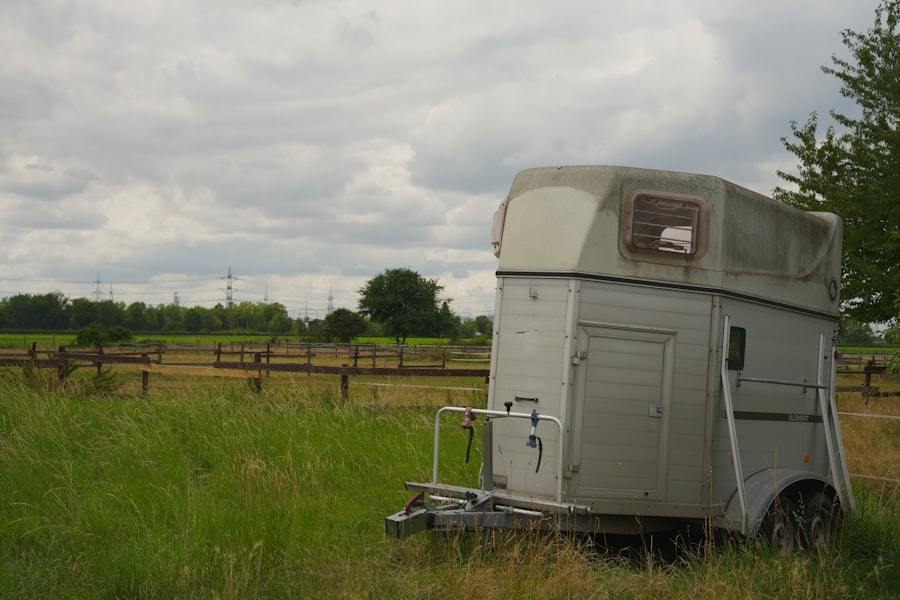Trailer homes, often referred to as mobile homes or manufactured homes, offer a unique blend of affordability and flexibility that appeals to a diverse range of individuals and families. One of the most significant advantages of trailer homes is their cost-effectiveness. Compared to traditional site-built houses, trailer homes typically come with a lower price tag, making homeownership accessible to those who might otherwise struggle to enter the housing market.
For instance, the average cost of a new manufactured home can be significantly less than that of a conventional home, allowing buyers to invest in their living space without incurring crippling debt. In addition to affordability, trailer homes provide a level of mobility that traditional homes cannot match. This mobility allows homeowners to relocate their residences with relative ease, whether for job opportunities, lifestyle changes, or personal preferences.
For example, families may choose to move their trailer home closer to work or school districts that better meet their needs. This flexibility can be particularly appealing for retirees or individuals who enjoy traveling, as they can take their home with them rather than being tied down to a single location. Furthermore, many trailer parks offer amenities and community features that enhance the living experience, such as recreational facilities and social events, fostering a sense of belonging among residents.
Key Takeaways
- Trailer homes offer affordable and flexible housing solutions with easy mobility.
- Initial costs are lower than traditional homes, but ongoing expenses like maintenance should be considered.
- Various financing options, including loans and rent-to-own plans, make trailer homes accessible.
- Choosing the right location is crucial for convenience, safety, and community amenities.
- Customization and regular upkeep enhance comfort and longevity of trailer homes.
The Costs of Trailer Homes
While trailer homes are generally more affordable than traditional houses, it is essential to consider the various costs associated with purchasing and maintaining one. The initial purchase price is just one aspect; prospective buyers must also factor in additional expenses such as land acquisition, utility connections, and insurance. Depending on the location and size of the trailer home, these costs can vary significantly.
For instance, purchasing land in a rural area may be less expensive than in an urban setting, but it may also come with its own set of challenges regarding access to services and amenities. Moreover, ongoing costs such as property taxes, maintenance, and utilities should not be overlooked. While trailer homes can be energy-efficient, they still require regular upkeep to ensure they remain in good condition.
Homeowners should budget for repairs and maintenance tasks such as roof inspections, plumbing repairs, and appliance replacements. Additionally, if the trailer home is located in a park, there may be monthly lot fees that cover community amenities and services. Understanding these costs is crucial for potential buyers to make informed decisions about their investment in a trailer home.
Financing Options for Trailer Homes

Financing a trailer home can differ significantly from securing a mortgage for a traditional house. Many lenders offer specific loan products tailored for manufactured homes, which can include personal loans or chattel loans. These types of financing typically have different terms and conditions compared to conventional mortgages.
For example, chattel loans are secured by the home itself rather than the land it sits on, which can lead to higher interest rates and shorter repayment periods. Buyers should carefully evaluate their options and consider working with lenders who specialize in manufactured home financing to find the best terms available. Additionally, some government programs may assist potential buyers in financing their trailer homes.
The Federal Housing Administration (FHA) offers loans specifically designed for manufactured homes, which can help lower-income families or first-time buyers secure financing with more favorable terms. These loans often require lower down payments and have more lenient credit score requirements compared to traditional mortgages. Understanding the various financing options available can empower prospective homeowners to make informed decisions that align with their financial situations.
Finding the Right Location for Your Trailer Home
| Criteria | Considerations | Impact on Trailer Home | Example Metrics |
|---|---|---|---|
| Land Cost | Price per acre or lot | Affects overall affordability and budget | Average cost: 3,000 – 10,000 per acre |
| Zoning Regulations | Local laws on trailer homes and land use | Determines if trailer home placement is allowed | Percentage of areas permitting trailer homes: 60% |
| Accessibility | Proximity to roads, highways, and public transport | Ease of commuting and transportation of trailer | Average distance to highway: 2 miles |
| Utilities Availability | Access to water, electricity, sewage, internet | Essential for comfortable living and functionality | Utility hookup availability: 85% of sites |
| Environmental Factors | Flood zones, soil stability, weather conditions | Safety and durability of trailer home placement | Flood zone risk: Low to moderate |
| Community Amenities | Nearby schools, hospitals, shopping, parks | Quality of life and convenience | Distance to nearest hospital: 5 miles |
| Resale Value | Market trends and demand in the area | Potential for property value appreciation | Annual appreciation rate: 2-4% |
Choosing the right location for a trailer home is a critical decision that can significantly impact the quality of life for its residents. Factors such as proximity to work, schools, healthcare facilities, and recreational opportunities should be carefully considered when selecting a site. For instance, families with children may prioritize locations near reputable schools or parks, while retirees might seek out quieter areas with access to healthcare services and community activities.
In addition to practical considerations, the environment surrounding the trailer home plays a vital role in overall satisfaction. Some individuals may prefer rural settings that offer peace and tranquility, while others might opt for urban locations that provide vibrant social scenes and easy access to amenities. Furthermore, zoning regulations and land use policies can affect where trailer homes can be placed; potential buyers should familiarize themselves with local laws to ensure compliance and avoid future complications.
Customizing Your Trailer Home
One of the appealing aspects of trailer homes is the potential for customization. Unlike traditional homes that may have strict architectural guidelines or limitations imposed by homeowners’ associations, trailer homes often allow for more personal expression in design and layout. Homeowners can choose from various floor plans, finishes, and features to create a living space that reflects their unique tastes and lifestyles.
For example, some may opt for open-concept designs that maximize space and light, while others might prefer more traditional layouts with defined rooms. Beyond interior design choices, homeowners can also enhance their outdoor spaces by adding decks, porches, or landscaping elements that complement their trailer home. These modifications not only improve aesthetics but can also increase property value over time.
Additionally, energy-efficient upgrades such as solar panels or improved insulation can lead to long-term savings on utility bills while contributing to a more sustainable living environment.
Maintenance and Upkeep of Trailer Homes

Maintaining a trailer home requires diligence and attention to detail to ensure its longevity and comfort. Regular inspections are essential for identifying potential issues before they escalate into costly repairs. Homeowners should routinely check for signs of wear and tear on roofing materials, siding, plumbing systems, and electrical components.
For instance, ensuring that gutters are clear of debris can prevent water damage and mold growth, while inspecting seals around windows and doors can improve energy efficiency. Seasonal maintenance tasks are also crucial for preserving the integrity of a trailer home. In colder climates, homeowners should winterize their plumbing systems to prevent freezing pipes, while those in warmer regions may need to focus on cooling systems and ventilation.
Additionally, keeping up with routine maintenance on appliances—such as cleaning refrigerator coils or replacing air filters—can extend their lifespan and enhance overall efficiency.
Community Living in Trailer Parks
Living in a trailer park offers a unique sense of community that many residents find appealing. These parks often foster close-knit relationships among neighbors through shared experiences and communal activities. Many parks organize social events such as potlucks, game nights, or holiday celebrations that encourage residents to connect and build friendships.
This sense of belonging can be particularly beneficial for individuals who may feel isolated in more traditional housing situations. Moreover, trailer parks often provide amenities that enhance the living experience for residents. Common features may include swimming pools, playgrounds, clubhouses, or fitness centers that promote an active lifestyle and encourage social interaction among residents.
The shared responsibility for maintaining common areas also fosters a sense of pride in the community as residents work together to create an inviting environment.
The Future of Trailer Homes in Affordable Housing
As housing affordability continues to be a pressing issue across many regions, trailer homes are emerging as a viable solution for addressing this crisis. With rising property prices and stagnant wages making traditional homeownership increasingly unattainable for many individuals and families, manufactured homes present an alternative that combines affordability with flexibility. The ability to produce these homes efficiently in factories allows for quicker construction times compared to traditional building methods.
Furthermore, as urban areas grapple with housing shortages and increasing demand for affordable options, trailer homes can be integrated into existing communities through innovative zoning practices and land use policies. By promoting the development of manufactured home communities within urban settings or repurposing underutilized land for trailer parks, cities can create diverse housing options that cater to various income levels while fostering inclusivity. In conclusion, the future of trailer homes holds promise as an essential component of affordable housing strategies.
As awareness grows regarding the benefits of manufactured homes—such as cost savings, mobility, customization options, and community living—more individuals may consider this alternative path toward homeownership. By embracing innovative solutions and fostering supportive policies around trailer homes, communities can work towards creating sustainable living environments that meet the needs of all residents.



